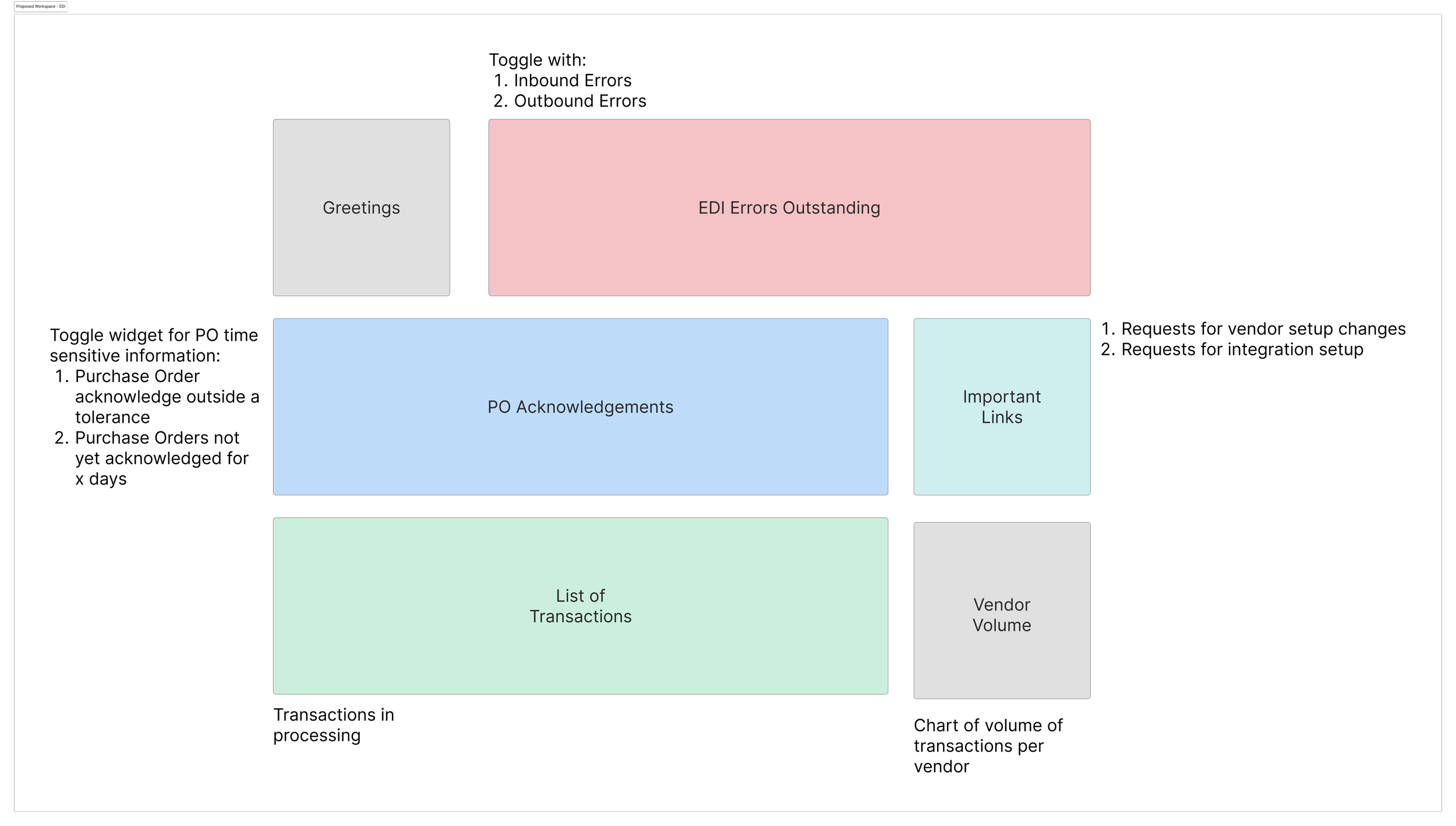Case Study 1
As part of my ongoing work at Infor, I designed and implemented a solution to optimize EDI connections, addressing key pain points in the supply chain management process.
Problem
Prior to implementing this workspace, the EDI process was riddled with inefficiencies. Teams spent significant time manually processing purchasing files and addressing errors from various suppliers. This was slowing down the overall supply chain and creating delays in order processing and acknowledgments.
The challenge was twofold:
Managing errors: Identifying and resolving inbound and outbound errors in real-time.
Improving transaction visibility: Ensuring teams could see the volume of transactions and identify any failed or pending transactions at a glance.
Key Requirements
The workspace needed to handle the following aspects of EDI processing:
Inbound errors
Outbound errors
Vendor setup changes
Integration setup requests
EDI work errors
Transaction processing visibility
Transaction volume per vendor
Purchase order acknowledgments outside of tolerance
Purchase orders unacknowledged for a specified time frame
Design and Solution
To address these challenges, I created a draft wireframe based on the value proposition that provided a clear hierarchy of information. The workspace was divided into key widgets that delivered essential insights while allowing users to interact and drill down into specific issues.
Greeting box: Positioned at the top left of the workspace for a welcoming interface.
EDI Errors: A toggle feature that allowed users to view inbound errors, outbound errors, or both. This was displayed prominently, so users could immediately see and address outstanding errors.
Purchase Order (PO) Acknowledgments: A widget dedicated to time-sensitive information such as purchase order acknowledgments outside of tolerance or unacknowledged for a specified number of days.
Important Links: A set of quick links to areas like vendor EDI setup and integration requests. This was intentionally left flexible to allow input from the product manager.
Transaction Processing: A chart that displayed the volume of transactions per vendor and a list of transactions categorized by area (e.g., purchasing, accounts payable, contracts). This included clickable links for failed or pending transactions.
Vendor Volume by Transactions: A dual-view feature with a chart showing the top five vendors (with customizable filters for time frame and vendor) and a grid view displaying transaction details by vendor and date.
User Feedback and Refinements
After presenting the initial wireframe, we held discussions with actual users to gather feedback. This led to several refinements:
The top box was updated to include a consolidated view of all outstanding EDI work (errors, processing, and warnings), with inbound and outbound errors categorized under distinct boxes.
Users requested the ability to open a pop-up modal for more detailed views, enabling quick exploration of issues directly from the dashboard.
Additional feedback led to the inclusion of failed purchase order acknowledgments and the ability to filter vendor transaction volumes by customizable criteria.
EDI Administrator Persona
My goals
Automate purchasing processes
Handle message/transaction errors
Setup data and configuration for vendor or account changes
Create reports on message volume
My ideal experience
Alerts for: upcoming new setups, vendors, locations
Error messages that can specify which field caused the error
Shortcuts in setting up new vendor data/accounts
Metrics and dashboard for processed messages per vendor
View a widget for outbound errors
My pain points
Manually figuring out what could be missing in the transactions which are causing errors
There are too many exchange records/messages, even old ones no longer relevant for my review.
Missing widget for outbound with errors
Reports/metrics generated manually
Message errors becoming the trigger to setup new configurations. This requires extra work to handle the errors. Scenarios include new vendors or new vendor requirements which can notify me in advance.
Batch uploads/setups using Infor Spreadsheet Designer (ISD), new setups requiring new ISD batch upload templates.




